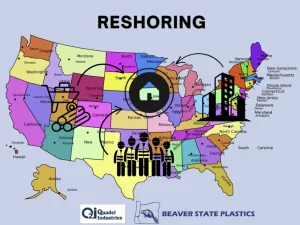The total number of jobs announced since 2010 is nearly 1.6 million after the government’s reshoring initiatives. Reshoring in manufacturing involves bringing production back to the original country from overseas. This shift is due to supply chain challenges and rising foreign costs. In this article, we’ll cover why reshoring is gaining traction, its benefits, and the challenges it presents.
Table of Contents
ToggleKey Takeaways
- Reshoring is driven by supply chain disruptions, rising overseas employment costs, and increasing consumer demand for locally sourced products.
- Domestic manufacturing enhances control over production, improves supply chain management, and offers stronger intellectual property protections. It also lessens the risks of shipping delays.
- Government incentives and policies significantly facilitate reshoring initiatives, resulting in substantial job creation and economic revitalization in local communities.
Key Factors Driving the Reshoring Movement

Several key factors have drawn the campaign for reshoring. One of the most significant drivers is the disruptions caused by global events and geopolitical tensions. These disruptions changed how the world views global distribution channels or global supply chains. Manufacturers were prompted to limit their exposure to external risks to solve these issues by reshoring their operations.
The rise in employment costs overseas, especially in manufacturing jobs and transportation costs, has become less economically viable as this also increases wages. This change has lessened the financial benefits of offshoring and, thus, is less compelling. This effect on the total economic benefits of offshoring encouraged the companies to reconsider their manufacturing strategies and turn to local production to remediate these costs.
A trend also shows a growing consumer demand for locally sourced products. Many value the quality and sustainability of goods made closer to home. This shift in consumer preferences has pushed companies to embrace more regionalized production systems. These systems aligned their manufacturing operations with the market’s wants and fostered deeper relationships with their customer network.
Strategic Advantages of Domestic Manufacturing

Reshoring enables companies to have greater control over the production processes. Thus, better quality is maintained, and products are enhanced when production can be easily managed because it is closer to the source. With the right proximity, manufacturers can oversee every aspect of the production process. This factor assures higher standards and fewer defects.
Domestic manufacturing streamlines supply chain management, which makes resolving supplier issues quicker and more efficient. Improving supply chain management minimizes logistical challenges and streamlines transportation, reducing overall costs. One of the most significant benefits of this improvement is that it enhances operational efficiency.
Another benefit of domestic manufacturing is that it offers stronger intellectual property protections. This security protection safeguards companies’ innovations and proprietary technologies. The strong legal framework in the United States ensures a secure environment for businesses, protecting them from intellectual property theft and ensuring their competitive edge.
Impact of Government Policies on Reshoring Efforts

Government policies have been instrumental in driving reshoring initiatives, providing a range of incentives to encourage manufacturing locally. These incentives include tax breaks, grants, and infrastructure investments designed to make reshoring financially attractive for businesses. The effectiveness of these incentives is evident in the more than 1,594 reshoring cases reported between 2010 and 2021, showcasing a significant return of manufacturing operations to the U.S.
A great example of this is Grand River Aseptic Manufacturing (GRAM), a life sciences manufacturer based in Grand Rapids, Michigan. Previously involved in “Operation Warp Speed,” GRAM invested $160 million to expand its fill-and-finish facilities. The company will receive $120 million in U.S. government contracts to support the project. This expansion will boost GRAM’s production capacity, allowing it to manufacture for both pharmaceutical companies and the federal government.
Government Incentives
Tax breaks: The Inflation Reduction Act (IRA) offers tax credits for electric vehicles and EV batteries. The foreign derived intangible income (FDII) tax deduction allows companies to claim a deduction on income from goods produced in the US and sold overseas.
Grants: The government is expanding access to capital for small manufacturers.
Infrastructure investment: The Infrastructure Investment and Jobs Act (IIJA) funds workforce training and other projects.
Government Goals
Technological leadership: The US government is investing in maintaining technological leadership.
Supply chain resilience: The COVID-19 pandemic highlighted the need for more local and regional manufacturing.
Other Considerations
Labor costs: global labor costs have risen, and there is a tightening in the availability of talent
Geopolitical risks: unpredictable events like pandemic-related lockdowns and wars can introduce risk and uncertainty for manufacturers.
State policies: there are various policies and incentives that support US-based manufacturing
Specific legislative initiatives have also played a crucial role in promoting local manufacturing.
The Inflation Reduction Act: boosts sectors like vehicles and semiconductors by providing substantial financial support
The CHIPS for America Act provides $52 billion in subsidies to bolster US semiconductor manufacturing, address critical supply chain vulnerabilities, and enhance national capabilities.
Government Contracts: have helped promote reshoring. One example is the US Department of Defense, which has awarded major contracts to boost domestic microelectronics production. This move enhanced the technological and manufacturing capabilities of domestic suppliers.
Additionally, the AM Forward initiative launched by the Biden Administration focuses on strengthening distribution channels through additive manufacturing, enhancing overall supply chain resiliency.
These government policies signify a reinvigoration of U.S. industrial policy, positively impacting the local manufacturing landscape. By creating a more supportive environment for businesses, these policies encourage reshoring and foster innovation, job creation, and economic growth.
Case Studies in Successful Reshoring
Here are some examples of companies that have long brought their production back home to show you how reshoring initiatives have been constantly progressing. (Published by Reshore Now)
| Company Name | What They Do |
| Jefferson Rubber | Jefferson Rubber specializes in custom rubber molding solutions for various industries. |
| The Original Granite Bracket Company | This company designs and manufactures support brackets for granite and other countertop materials. |
| Mayfield Plastics | Mayfield Plastics offers custom thermoforming services, producing plastic components for diverse applications. |
| Chicago White Metal Casting, Inc. | A leader in die casting, Chicago White Metal Casting provides precision aluminum, magnesium, and zinc die castings. |
| Chrysler | Chrysler is a major automotive manufacturer known for producing cars and trucks. |
| Mitchell Metal Products | Mitchell Metal Products specializes in metal stamping and fabrication services. |
Several companies have successfully navigated the reshoring landscape, setting examples for others to follow. One notable case is Motorola Solutions, which moved its molded product manufacturing from China back to Chicago. This move enhanced their production capabilities and demonstrated a commitment to manufacture locally.
Chrysler is another example of successful reshoring. By bringing components back to the U.S., the company has strengthened its local production capabilities and contributed to job creation, highlighting the economic benefits of reshoring.
CelebriDucks, known for its iconic rubber ducks, has also returned its manufacturing to the U.S., aligning with the product’s origins and reinforcing the brand’s commitment to local production.
Allison Transmission has made significant investments in reshoring by purchasing equipment from C & B Machinery, enhancing its production processes and capabilities.
These successful reshoring initiative efforts have collectively resulted in significant job creation, with over 260,000 jobs returning to the U.S. in 2021 alone, showcasing the tangible impact of this movement on the domestic labor market. Here’s where you can find more real-world examples of successful reshoring initiatives.
Challenges and Solutions in Reshoring Initiatives
Reshoring, with all its benefits, still has challenges. One of the primary concerns is the higher employment costs in the US compared to many offshoring locations. Moreover, there is a significant skills gap in the US labor market. The fewer opportunities given to US workers to improve their skills in modern manufacturing processes during the previous years resulted in a shortage of trained workers.
To help cope with higher employment costs, companies are turning to automation. Automation helps lessen the impact of higher employment costs plus addresses workforce shortages by streamlining production processes. Advanced technologies, such as robotics and artificial intelligence, help companies maintain high productivity while reducing dependence on manual labor.
Furthermore, investing in modern infrastructure is crucial for competitive production. Upgrading outdated manufacturing facilities and adopting state-of-the-art technologies can significantly enhance operational efficiency and product quality, making reshoring a more viable and attractive option for companies.
Economic Benefits of Reshoring for Local Communities
The economic benefits of reshoring extend beyond the manufacturing sector, positively impacting local communities. One of the most notable benefits is job creation, with over 260,000 jobs brought back to the U.S. in 2021 alone. Reshoring initiatives help revitalize communities affected by deindustrialization, contributing to economic recovery and growth.
Reshoring also increases local construction, real estate, and utility demand, as new manufacturing facilities require substantial infrastructure investment. This surge in demand stimulates local economies and creates additional job opportunities in various sectors.
Moreover, a locally sourced workforce enhances product innovation. By engaging local workers in the production process, companies can tap into a skilled workforce that brings fresh perspectives and innovative ideas, further driving competitiveness and growth.
The Role of Technology in Modern Reshoring
Investing in advanced technologies like robotics and artificial intelligence is crucial for modernizing manufacturing infrastructure and supporting reshoring efforts. These technologies enhance production efficiency and reduce dependence on offshoring by enabling higher output with fewer resources.
Automation plays a significant role in managing risks and total costs, making reshoring more cost-competitive. By integrating intelligent technologies, companies can achieve greater supply chain flexibility and resilience, ensuring their operations remain robust and adaptive to changing market conditions.
Future Trends in Reshoring
The future of reshoring will continue to be shaped by geopolitical tensions, trade policy changes, and disruptions like the COVID-19 pandemic. These factors have already influenced many companies to reassess their global supply chains and consider reshoring as a strategic move.
Additionally, the concept of nearshoring is gaining traction. Nearshoring involves relocating foreign manufacturing to nearby countries, such as Canada, Mexico, and Caribbean nations. This strategy allows companies to mitigate risks while still benefiting from cost efficiencies. Popular nearshoring locations offer proximity to the U.S. market, reducing transportation costs and enhancing supply chain resiliency.
As these trends continue to evolve, it is clear that reshoring will remain a critical strategy for companies looking to secure their distribution channels and respond to market demands effectively. Reshoring enables manufacturers to provide customers with the products they want at lower costs and faster rates.
Summary
In summary, the reshoring movement is driven by supply chain disruptions, rising overseas employment costs, and consumer demand for locally sourced products. The strategic advantages of local manufacturing, supported by government policies and technological advancements, make reshoring an attractive option for many companies. Successful case studies and the economic benefits for local communities further highlight the positive impact of this trend.
As we look to the future, reshoring will continue to play a pivotal role in strengthening domestic production and enhancing supply chain resilience. By embracing this movement, companies can secure their operations, foster innovation, and contribute to the economic growth of local communities.
Frequently Asked Questions
What is U.S. reshoring?
U.S. reshoring refers to the movement of manufacturing and supply chain operations back to the United States, driven by the goal of creating well-paying jobs and reducing the total cost of ownership. This trend reflects a collective shift in thinking away from offshoring as a cheaper alternative.
Is U.S. manufacturing making a comeback?
Yes, U.S. manufacturing is experiencing a resurgence. The government provided ways to encourage companies by supporting them with federal funding and recovery in manufacturing works across 30 states. This marks a significant recovery for the sector since the 1970s.
What are the main factors driving the reshoring movement?
The main factors driving the reshoring movement are disruptions in the supply chain from geopolitical tensions and global events, rising labor costs abroad, and a growing consumer demand for locally sourced products. These elements collectively encourage businesses to reconsider their manufacturing and sourcing strategies.
What are the strategic advantages of reshoring?
Reshoring offers significant advantages, which collectively support organizational resilience and operational effectiveness. Some of these advantages are enhanced production control, streamlined supply chains, improved quality management, better protection of intellectual property, and logistical efficiencies.
How have government policies impacted reshoring efforts?
The government has intensified efforts to support restoring initiatives through government policies, which include tax incentives, grants, and significant legislative initiatives. One example of government initiatives that aim to help encourage reshoring efforts is the Inflation Reduction Act, which enables companies to relocate production back to the US. These measures provide vital support for local manufacturing and economic growth.
We Will Help You
If you think bringing manufacturing back home will give you a lesser advantage, think again. There is no better way to manage your business than by working it yourself. With all the costs and risks associated with offshoring and adding them, you will find out that it will be cheaper to have your products MADE IN THE USA. Contact us for more information on how you can reach your injection molding goals by gaining greater control over your business.
